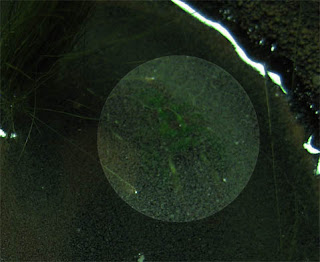Crocodiles and catfish live in water. It's a commonly known scientific fact. What that means for me is simple -- I've got to be able to replicate water. There's going to be water on everyone's bases, but there's also going to be water in my upcoming swamp templates.
The problem is that convincing water is difficult to make. I've used PVA glue in the past -- probably better known to readers as Elmer's Glue -- but it's terrible for that purpose.
You see, PVA glue dries via evaporation. Whatever chemical component keeps the substance fluid escapes, leaving behind a dry, solid mass. This is perhaps one of the worst things ever for creating flat, predictable shapes.
1. You'll get a bowed shape. The topmost layer and the edges of the glue will dry first. As your glue loses volume, it settles; the skin in the center has less rigidity than the edges, meaning that your glue pool will settle into a bowl. It's very un-water-like.
2. You'll see gaps form around the edges. You can see this below in my Stalker:

See that black line between the plastic base and the gray, dried glue? That's a gap. You can actually feel the glue shifting if you touch it -- it's only anchored in some places. Eventually, this glue will come right off. This phenomenon is related to the bowing above; as the center mass dries and loses volume, it pulls the dried sections in.
3. Bubbles and craters form. This is especially catastrophic, and can be seen clearly in the test I ran on a mass of PVA glue:


(The black and brown gunk is ballast. I use a mix of wood flakes, sand and rocks; some of it floats. I tried to make this test realistic by basing the bottom of this vacuum-sealed plastic shape before putting the PVA glue down.)
I don't really know why these happen, but I assume they're related to gas being trapped beneath dried glue. My guess is that pockets of gas meet up and escape catastrophically when the glue's shrinking volume stretches a dried section enough to allow the gas to escape.
4. The glue dries in sections. This is the PVA glue, over a week after I'd laid it down:
That white line at the bottom, just above the gravel, is wet glue! Eight days later! The dried glue above created a sealed chamber that kept the other glue wet.
I tried this same experiment with clear Tacky Glue and had the similar results. The Tacky Glue has two significant advantages, though, and I'll use it on the bases -- the shrinkage is far smaller, and the color control, when dye is added to it, is much better.
For the swamp templates -- I'll have to use the far more expensive Realistic Water or Water Effects products (from Woodland Scenics and Games Workshop, respectively). However, even those products have problems with shrinking volume, and the Realistic Water looks like it'll be a nightmare to color-fix. We'll see!
 You can see that this one has a different feel already -- that swirling green mass reflects that this swamp is going to be non-idyllic. The idea on this one is to have dead and rotting matter, like logs and twisted vines, and something big and unidentifiable will be slithering about in the depths. The water's coming in two layers on this one -- first will be a green-yellow layer that's got flock floating in it; the second will be a lighter layer that's relatively clear of debris.
You can see that this one has a different feel already -- that swirling green mass reflects that this swamp is going to be non-idyllic. The idea on this one is to have dead and rotting matter, like logs and twisted vines, and something big and unidentifiable will be slithering about in the depths. The water's coming in two layers on this one -- first will be a green-yellow layer that's got flock floating in it; the second will be a lighter layer that's relatively clear of debris. Here's the stuff in progress -- what's going to be a floating log, a wilted and disgusting plant, and the something that'll be swimming in the muck. If you can't tell, it's a scaled beast of some kind; its back is just breaking the water. (Think of those old pictures and drawings of Nessie -- how it's supposed to break the surface like a snake undulating up and down, rather than left to right.)
Here's the stuff in progress -- what's going to be a floating log, a wilted and disgusting plant, and the something that'll be swimming in the muck. If you can't tell, it's a scaled beast of some kind; its back is just breaking the water. (Think of those old pictures and drawings of Nessie -- how it's supposed to break the surface like a snake undulating up and down, rather than left to right.)



























